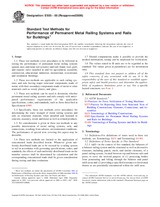We need your consent to use the individual data so that you can see information about your interests, among other things. Click "OK" to give your consent.
ASTM E935-00(2006)
Standard Test Methods for Performance of Permanent Metal Railing Systems and Rails for Buildings
STANDARD published on 1.4.2006
The information about the standard:
Designation standards: ASTM E935-00(2006)
Note: WITHDRAWN
Publication date standards: 1.4.2006
SKU: NS-48519
The number of pages: 7
Approximate weight : 21 g (0.05 lbs)
Country: American technical standard
Category: Technical standards ASTM
Annotation of standard text ASTM E935-00(2006) :
Keywords:
building components, railing systems (metal), rails (metal), test methods, thrust resistance, ICS Number Code 91.060.30 (Ceilings. Floors. Stairs)
Additional information
| Significance and Use | ||||||||||||||
|
These test methods are intended to provide information from which applicable design data can be derived for the performance of metal railing systems and rails installed and fastened to structural elements of concrete, masonry, wood, and metal as well as related products. Typical floor-mounted railings are shown in Fig. 1.
|
||||||||||||||
| 1. Scope | ||||||||||||||
|
1.1 These test methods cover procedures to be followed in testing the performance of permanent metal railing systems (guard, stair, and ramp-rail systems) and rails (hand, wall, grab, and transfer rails) installed in and for agricultural, assembly, commercial, educational, industrial, institutional, recreational, and residential buildings. 1.2 These test methods are applicable to such railing systems and rails having major structural components made of metal, with their secondary components made of metal or other materials such as wood, plastic, and glass. 1.3 These test methods can be used to determine whether permanent metal railing systems and rails comply with anticipated performance requirements of the applicable specifications, codes, and standards, such as those described in Specification E 985. 1.4 Specifically, these test methods cover procedures for determining the static strength of metal railing systems and rails as structural elements when installed and fastened to concrete, masonry, wood, and metal as well as related products. 1.5 No consideration is given in these test methods to any possible deterioration of metal railing systems, rails, and connections, resulting from adverse environmental conditions. The performance of special tests covering this aspect may be desirable. 1.6 These test methods are limited to the application of concentrated loads described herein. Whenever given uniformly distributed loads are to be resisted by a railing system or rail in accordance with governing specifications, codes, and standards, the effects of such uniformly distributed loads on the member stresses shall be determined by calculation and the corresponding concentrated loads shall be given consideration during testing and data evaluation. 1.7 Should computations make it possible to provide the needed information, testing can be employed for verification. 1.8 The values stated in SI units are to be regarded as the standard. The values given in parentheses are for information only. This standard does not purport to address all of the safety concerns, if any, associated with its use. It is the responsibility of the user of this standard to establish appropriate safety and health practices and determine the applicability of regulatory limitations prior to use. For a specific hazard statement, see Note 0. |
||||||||||||||
| 2. Referenced Documents | ||||||||||||||
|
We recommend:
Technical standards updating
Do you want to make sure you use only the valid technical standards?
We can offer you a solution which will provide you a monthly overview concerning the updating of standards which you use.
Would you like to know more? Look at this page.




 Cookies
Cookies
